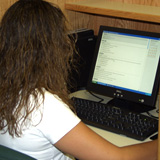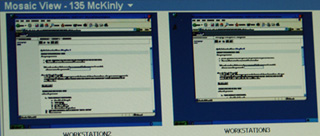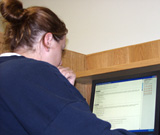
Most faculty would wince at the mere thought of putting their exams online. Security
risks and the potential for academic dishonesty
have kept consideration of this topic to a minimum—until now. Dr. Mark Stanton, associate professor of
psychology, has not been deterred by the pitfalls of
electronic testing.
In the summer of 2003, Stanton and graduate
research assistant Barney Pagani formulated a
daring vision for web-based assessments for Psychology 312: Learning and Motivaton. Through
a Technology-Enhanced Course Redesign
grant proposal, the Stanton-Pagani team crafted
a plan for a fully-equipped secure testing lab.
Patterned after testing center guidelines set forth by Educational Testing Services, the proposal
called for room design, carrels, computers, network
equipment, video surveillance, and .
Why go to such lengths to give exams? Stanton uses an instructional approach called the
Keller Method with favorable results. In keeping with the method, students take objective tests
to a mastery criterion before attending classes.
According to Stanton, “the hallmark of Keller is
mastery learning.”
Prior to class meetings, students must pass exams
as evidence of basic concept mastery. It’s a carrot and stick system where passing an exam is
the stick and subsequent admission to intensive class
meetings is the carrot. As a result, class time is more
effective because students can apply knowledge to
in-depth class discussions.

Screen shot of NetOp software
The Keller Method is also known for its feedback
mechanisms. Incorrect exam responses are followed
by feedback that directs the student to the correct source material. “Students need to know not
just when they’re wrong but where to go to clarify
their understanding,” Pagani mentioned.
The Keller Method stipulates that exams are to
be taken at the student’s discretion. In previous
semesters, Stanton’s exams were in a pencil and paper
format. Since students were able to set their own test-taking
schedule, administering and grading
exams and providing feedback was taxing.
Enter the need for an automated testing system.
The summer-long grant project produced a testing
environment that is as secure as it is supportive of
the instructional method. Aided by PRESENT staff
members Justin Schakelman and Jeff Whisler, the
team set out to launch the lab by fall of 2003.

Screen shot of surveillance cameras
Two major pieces make up the secure testing site:
software and hardware. Exams are managed by
. The learning management system “was
a natural fit,” Stanton said. “It organizes and
delivers exams to our exact specifications,” Pagani
added, “and it provides the necessary feedback to
students.”
automates the time-consuming task of
grading and guards against cheating. “Features like
student authentication and randomly generated
questions from sets of items are important to our
use of the Keller Method,” said Stanton.
has several lines of defense for those foolish enough
to attempt cheating. “We configured to
track students’ responses, scores, and attempts
right down to the second,” Pagani noted. “There’s
simply no easy way for students to take an exam
fraudulently.”
Tracking students’ movements is central to the security of this
instructional innovation. Stanton made it clear early
on that “protecting against academic dishonesty is
critical to the success of the Keller Method.” The team assembled a hardware infrastructure to
combat the cunning. They installed an
Internet-based video surveillance system and computer
monitoring program. The ceiling-mounted camera records and
archives all lab activity. Students cannot begin
until the proctor releases the exam using software
called NetOp. At any time, the proctor may use
NetOp to take over the student’s computer remotely
if there’s an appearance of impropriety.
The room has its own local area network which gives added control in keeping intrepid hackers out. The network has
a thick shield that “makes it virtually impossible
for outsiders to capture exam content,” said Jeff
Whisler, designer of the lab’s security system. All
six computers function as terminals with no access to disk
drives, ports, or any other medium to which content
could be saved.
 Amid all the passwords and precautions, the lab does “a very good job of streamlining the administrative
side of the Keller Method,” said Stanton.
More importantly, it works to improve student
achievement with less administrative overhead. In
a recent course method comparison study, Stanton
and Pagani found that test scores were significantly
higher in the Keller Method sections as compared
with traditional lecture sections.
Amid all the passwords and precautions, the lab does “a very good job of streamlining the administrative
side of the Keller Method,” said Stanton.
More importantly, it works to improve student
achievement with less administrative overhead. In
a recent course method comparison study, Stanton
and Pagani found that test scores were significantly
higher in the Keller Method sections as compared
with traditional lecture sections.
Some of Stanton’s students were especially impressed
with how easy it was to stop by the lab, take a test,
get feedback, and get on with life. Students also
reported that they learn more in the Keller group, “and that’s the name of the game,” Stanton added
with a smile.
